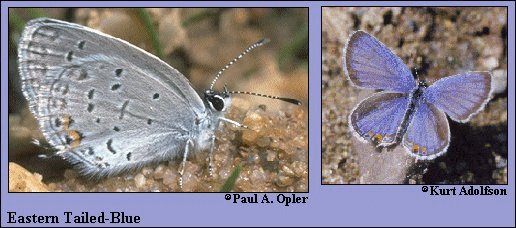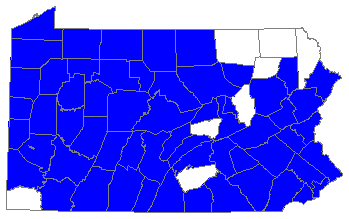 |
 

 |



Eastern Tailed-Blue (Everes comyntas [Godart])
Wing span: 7/8 - 1 1/8 inches (2.2 - 2.9 cm).
Identification: One narrow tail on hindwing. Upperside of male iridescent blue; summer females uniformly brown, spring females smaller with much blue at the wing bases. Underside of hindwing pale gray with black bar at end of cell, distinct black spots, and three large orange spots at outer margin near tail.
Life history: Males patrol near the host plants during daylight hours. Females lay eggs on flower buds; caterpillars eat buds, flowers, and seeds. The caterpillar hibernates, pupating the following spring. Although most Lycaenids do not perch with open wings, Eastern Tailed-Blues sometimes bask with their wings at a 45 angle.
Flight: Three broods from April-November in the north, many broods from February-November in the south.
Caterpillar hosts: Many plants in the pea family including yellow sweet clover (Melilotus officinalis), alfalfa (Medicago sativa); various species of vetch (Vicia), clover (Trifolium), wild pea (Lathyrus), and bush clover (Lespedeza); and others.
Adult food: This butterfly has a low flight and a short proboscis, thus is found at flowers close to the ground which are open or short-tubed. These include white sweet clover, shepherd's needle, wild strawberry, winter cress, cinquefoils, asters, and others.
Habitat: Many open, sunny places including weedy areas and disturbed habitats.
Range: Southeast Canada and Eastern United States west to western North Dakota, central Colorado, and central Texas. Also ranges from southeastern Arizona, western New Mexico, and west Texas south to Costa Rica.
Conservation: Not usually required.
The Nature Conservancy Global Rank: G5 - Demonstrably secure globally, though it may be quite rare in parts of its range, especially at the periphery.
Management needs: None reported.
References:
Opler, P. A. and G. O. Krizek. 1984. Butterflies east of the Great Plains. Johns
Hopkins University Press, Baltimore. 294 pages, 54 color plates.
Opler, P. A. and V. Malikul. 1992. A field guide to eastern butterflies. Peterson
field guide #4. Houghton-Mifflin Co., Boston. 396 pages, 48 color plates.
Scott, J. A. 1986. The butterflies of North America. Stanford University Press,
Stanford, Calif. 583 pages, 64 color plates.
Tilden, J. W. 1986. A field guide to western butterflies. Houghton-Mifflin Co.,
Boston, Mass. 370 pages, 23 color plates.
Author: Jane M. Struttmann
State and Regional References:
Glassberg, J. 1993. Butterflies Through Binoculars: A Field Guide to
Butterflies in the Boston-New York-Washington Region. Oxford Univ. Press,
New York, N.Y. 160 pp.
Layberry, R.A., Hall, P.W. & Lafontaine, D.J., 1998. The Butterflies of
Canada. University of Toronto Press, Toronto, ON. 280 pp.
Opler, P.A. 1998. A field guide to eastern butterflies, revised format.
Houghton Mifflin Co., Boston.
Shapiro, A.M. 1966. Butterflies of the Delaware Valley. American Entomological
Society Special Publication. Philadelphia, PA. 79 pp.
Tietz, H.M. 1952. The Lepidoptera of Pennsylvania. The Pennsylvania State
College School of Agriculture Agricultural Experiment Station. State
College, PA. 194 pp.
Wright, D.M. 1995, Atlas of Pennsylvania Butterflies. Special Private
Publication, Lansdale, PA. 22 pp.

